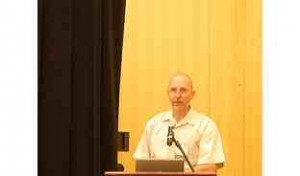There is a lot of discussion around the best way(s) to sequester carbon but the biggest discussion involves the issue of what is the best way to do this and what will be the long term effects. Several people took the stage during one of Sunday’s afternoon sessions called: Carbon Sequestration – The Path to the Promise.
 Theodor Friedrich with the Crop and Grassland Service of the FAO, along with Nathan Rudgers, with 25×25 Carbon Work Group, shared the podium to discuss the ability of farmers to capture and store atmospheric carbon in their soils as a way to reduce carbon emissions. This practice to be both a boon to the air and the soil as this could provide a new financial stream for farmers.
Theodor Friedrich with the Crop and Grassland Service of the FAO, along with Nathan Rudgers, with 25×25 Carbon Work Group, shared the podium to discuss the ability of farmers to capture and store atmospheric carbon in their soils as a way to reduce carbon emissions. This practice to be both a boon to the air and the soil as this could provide a new financial stream for farmers.
Friedrich focused on the role of soil in carbon sequestration noting that when soils are put into production they lose CO2. However, he said, this also makes them a big carbon sink and warned that a key element to the success of this process would be agricultural management of the soils. In the end, he cautioned that in regards to climate change, “agriculture must be a part of the solution, not part of the problem.
From there Rudgers took the stage to focus on how forestry can play in important role in carbon offset programs (cap and trade). He noted that under the cap-and-trade, regulated entities must reduce emissions or purchase offsets to cover them. He commented that his organization is looking at woody biomass which, “can be a robust contributor to energy solutions.”
To see the full presentation, visit IFAJ’s website.



